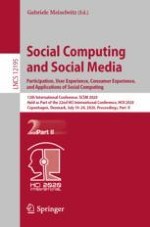This two-volume set LNCS 12194 and 12195 constitutes the refereed proceedings of the 12th International Conference on Social Computing and Social Media, SCSM 2020, held as part of the 22nd International Conference, HCI International 2020, which was planned to be held in Copenhagen, Denmark, in July 2020. The conference was held virtually due to the COVID-19 pandemic. The total of 1439 papers and 238 posters have been accepted for publication in the HCII 2020 proceedings from a total of 6326 submissions. SCSM 2020 includes a total of 93 papers which are organized in topical sections named: Design Issues in Social Computing, Ethics and Misinformation in Social Media, User Behavior and Social Network Analysis, Participation and Collaboration in Online Communities, Social Computing and User Experience, Social Media Marketing and Consumer Experience, Social Computing for Well-Being, Learning, and Entertainment.
